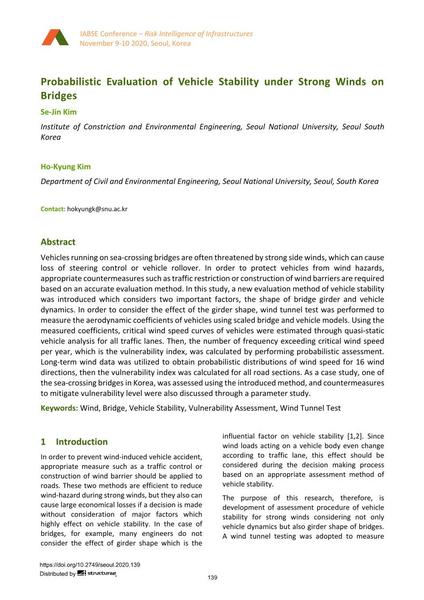Probabilistic Evaluation of Vehicle Stability under Strong Winds on Bridges

|
|
|||||||||||
Bibliografische Angaben
| Autor(en): |
Se-Jin Kim
(Institute of Constriction and Environmental Engineering, Seoul National University, Seoul South Korea)
Ho-Kyung Kim |
||||
|---|---|---|---|---|---|
| Medium: | Tagungsbeitrag | ||||
| Sprache(n): | Englisch | ||||
| Tagung: | IABSE Conference: Risk Intelligence of Infrastructures, Seoul, South Korea, 9-10 November 2020 | ||||
| Veröffentlicht in: | IABSE Conference Seoul 2020 | ||||
|
|||||
| Seite(n): | 139-142 | ||||
| Anzahl der Seiten (im PDF): | 4 | ||||
| DOI: | 10.2749/seoul.2020.139 | ||||
| Abstrakt: |
Vehicles running on sea-crossing bridges are often threatened by strong side winds, which can cause loss of steering control or vehicle rollover. In order to protect vehicles from wind hazards, appropriate countermeasures such as traffic restriction or construction of wind barriers are required based on an accurate evaluation method. In this study, a new evaluation method of vehicle stability was introduced which considers two important factors, the shape of bridge girder and vehicle dynamics. In order to consider the effect of the girder shape, wind tunnel test was performed to measure the aerodynamic coefficients of vehicles using scaled bridge and vehicle models. Using the measured coefficients, critical wind speed curves of vehicles were estimated through quasi-static vehicle analysis for all traffic lanes. Then, the number of frequency exceeding critical wind speed per year, which is the vulnerability index, was calculated by performing probabilistic assessment. Long-term wind data was utilized to obtain probabilistic distributions of wind speed for 16 wind directions, then the vulnerability index was calculated for all road sections. As a case study, one of the sea-crossing bridges in Korea, was assessed using the introduced method, and countermeasures to mitigate vulnerability level were also discussed through a parameter study. |
||||
| Stichwörter: |
Wind Brücke Windkanaluntersuchung Verletzbarkeitsbewertung
|
||||
